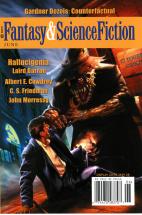
Cover by Max Bertolini
"Animal Magnetism" by Albert E. Cowdrey
"Counterfactual" by Gardner Dozois
"Why the Aliens Did What They Did to That Suburb of Madison, Wisconsin" by Tim McDaniel
"Hallucigenia" by Laird Barron
"The Protectors of Zendor" by John Morressy
"Terms of Engagement" by C. S. Friedman
One of the strangest short stories in a while may be “Why the Aliens Did What They Did to that Suburb of Madison, Wisconsin” by Tim McDaniel, a story whose title is practically as long as the story itself. This is a tale of a couple which engages in a variety of fetishistic sexual encounters. Rather than variety being the spice of life, however, they have discovered that even the most outré games have made their sex lives stale. The story gets its strength from the juxtaposition of the events in the story and the title, which the reader must bear in mind at the end of the tale.
When I was in graduate school, I rented an apartment which turned out to be infested with cockroaches, even after the landlord bug bombed the place, so “Terms of Engagement” by C. S. Friedman struck a nerve with me. Her story, about a graduate student living in a cockroach-infested apartment, manages to look at the situation humorously. In fact, the humor she uses is reminiscent of Harry Waller’s Pegasus-winning song, “Cockroaches on Parade.” Friedman’s heroine must live in an apartment rife with cockroaches, Palmetto bugs, and other similar critters. Her attempts at roachicide having failed, she turns to forming a peace treaty, with results that resolve other issues she finds herself having.
Gardner Dozois provides a multi-level alternate history with “Counterfactual.” This story of a different United States works on two levels. On the one hand, it is a look at the world in which Herbert Hoover’s vice president is Charles Lindbergh, and the newspaper reporters who have been sent to cover what should be a run-of-the-mill election, stop in a South which is heir to decades of guerrilla warfare after Robert E. Lee disappeared into the hills rather than surrender. On the other hand, Dozois’s narrator, Cliff, one of those reporters, spends his downtime writing counterfactual novels. Throughout the course of the story, Cliff ruminates on the meaning of history and the manner in which alternate histories might arise. It is a sign of Dozois’s ability as a writer that both levels of the story work extremely well, and while the editorial world of science fiction may lament his return to writing fiction, the reading world has something to cheer about.
The are many monsters common to fantasy stories, from vampires to lycanthropes to…CPAs. In “Animal Magnetism,” Albert E. Cowdrey examines the life of Henry Greene, a gay CPA from New Orleans. Following his break-up with long-time lover Clem, Greene throws himself into tax preparation season and acquires a dog to keep him company. The pet, of course, can’t completely fill in the hole left by his ex-lover, but given the exigencies of tax season, Greene doesn’t really have time to pursue any relationship, even finding himself ignoring Trixie, his new dog. However, the burdens of the season, mixed with his loss of human companionship, begin to get to Greene who finds himself hallucinating that Trixie is actually a woman. Cowdrey handles Greene’s relationship with Trixie quite well and clearly shows him coming to rely on the animal companionship she provides, even as he questions his own grasp on sanity.
Although Laird Barron’s “Hallucigenia” has a feel of a 1930s Astounding science fiction story mixed with H.P. Lovecraft, it also presents itself with a modern sensibility. Rolling a detective story in as well removes some of the atmosphere, which tends to be so important to a Lovecraftian tale, but nevertheless, Barron’s story still manages to be successful. Following an outing in the Washington countryside, Wallace Smith and his new (much younger) wife, Helen, find themselves in a barn with strange graffiti on it. Injuries suffered in the barn from a horse lead Wallace to use his tremendous resources to learn about the Choates, the family which owned the barn before it was left derelict. As his investigations proceed, using a wide variety of friends and retainers rather than solo, Wallace and his people learn more about the Choates and begin to experience strange happenings. Barron loads “Hallucigenia” with a great deal of background for his characters and their relationships, providing a suitable number of red herrings for the reader. While the moments of skin-crawling creepiness are kept to a minimum, they do, in fact, exist. Barron’s story provides complexity amidst its old-time feel and ultimately does tie in to the pulp era to which it hearkens. Its feel is quite different from any of the other stories in this issue of F&SF, and ultimately it works quite well.
“The Protectors of Zendor” is another entry in John Morressy’s long-running Kedrigern series. In this story, Kedrigern and his wife, Princess, find themselves trying to avert a war their employers are trying to start. They have also found themselves promising to help a woman whose infant has been cursed by a bog-fairy. The two situations appear to have nothing in common, but Morressy and Kedrigern manage to find a link in this light-hearted fantasy story.